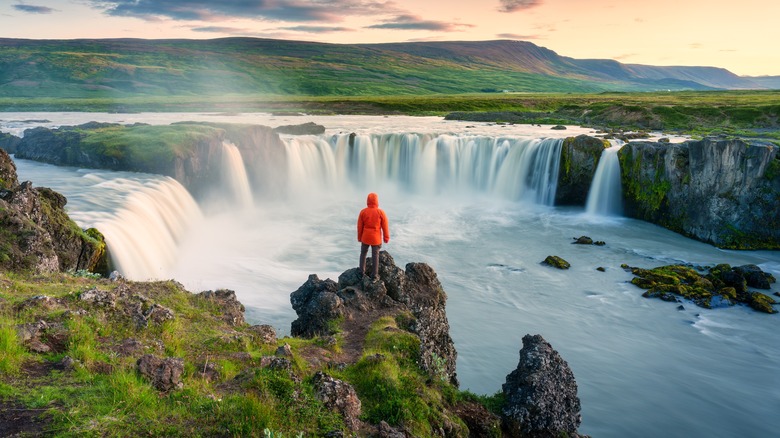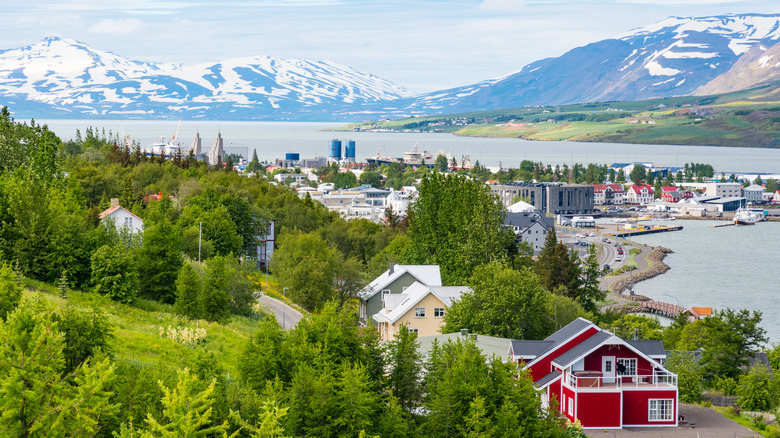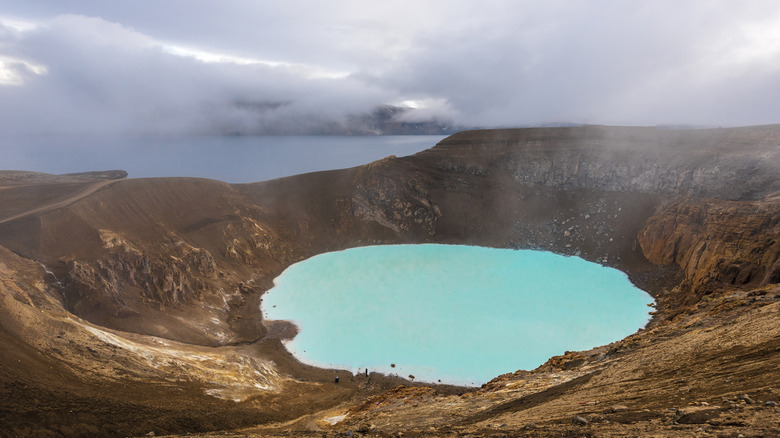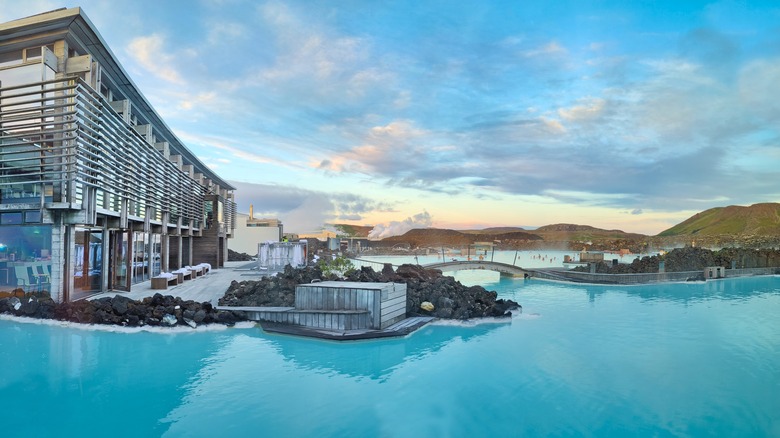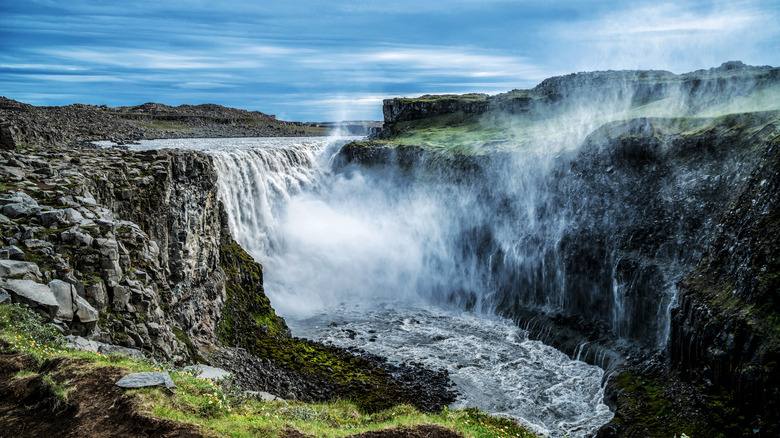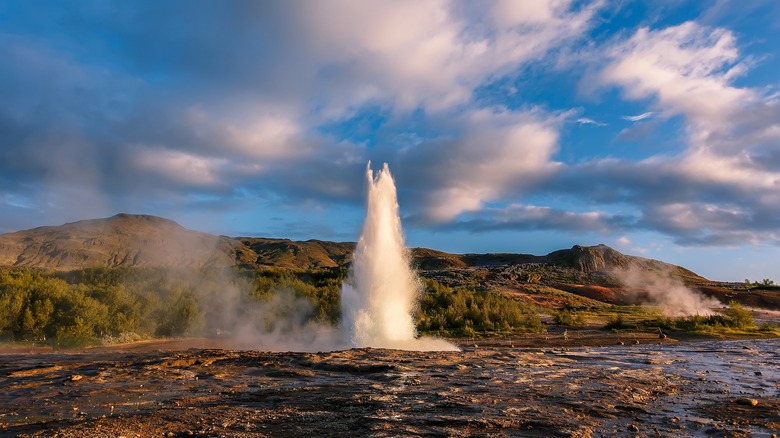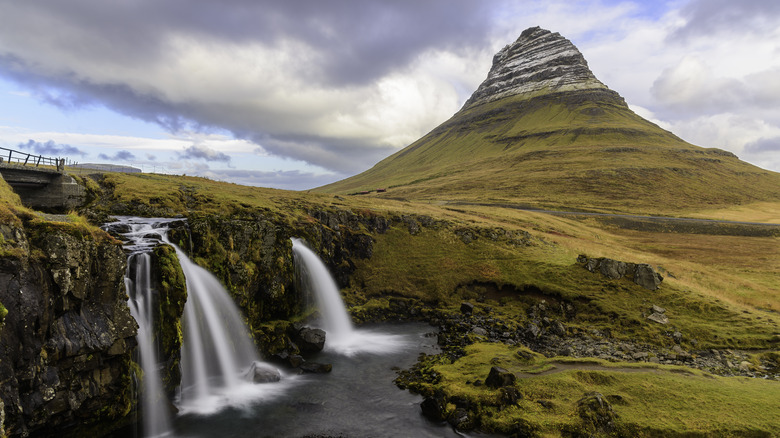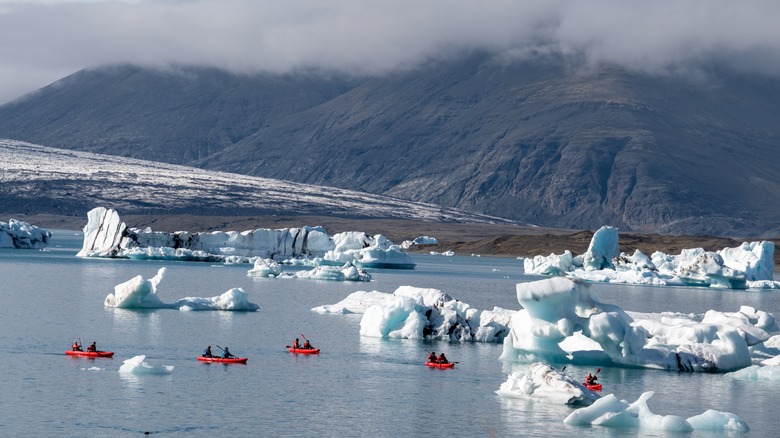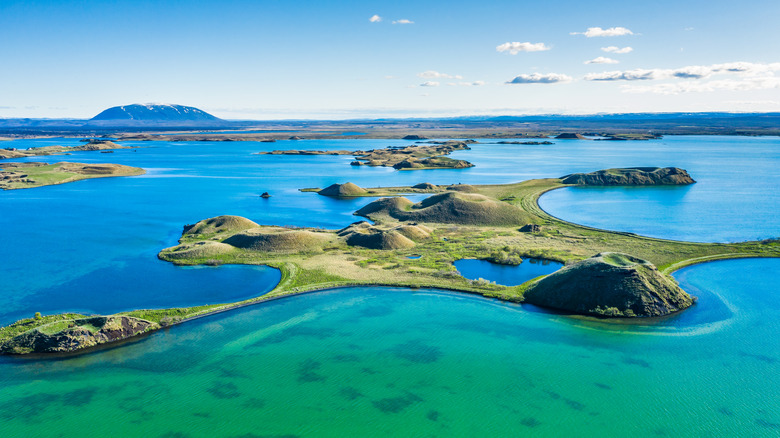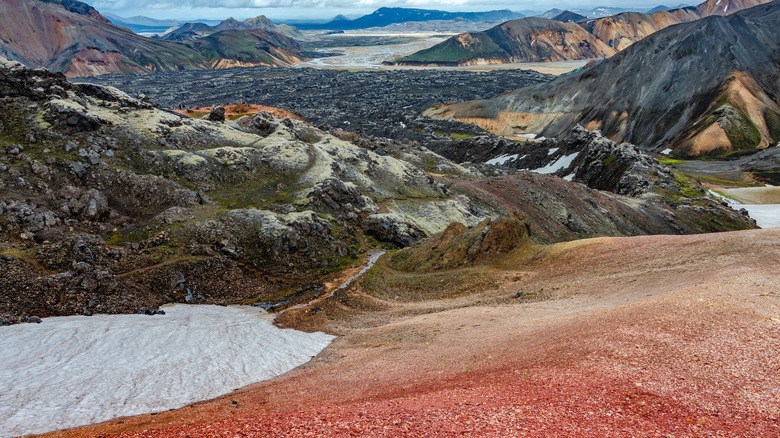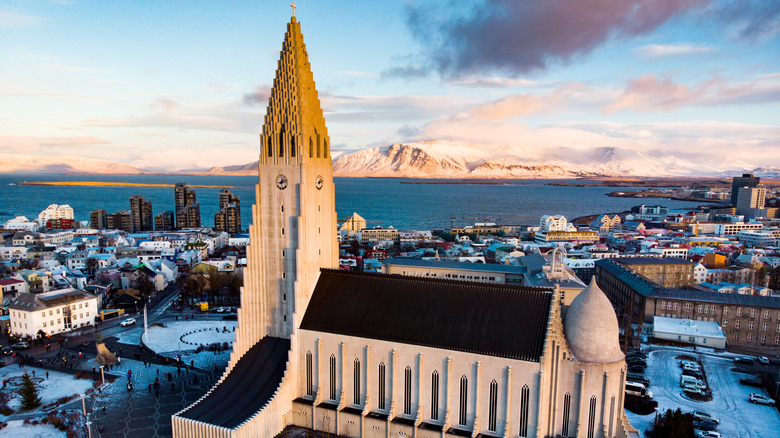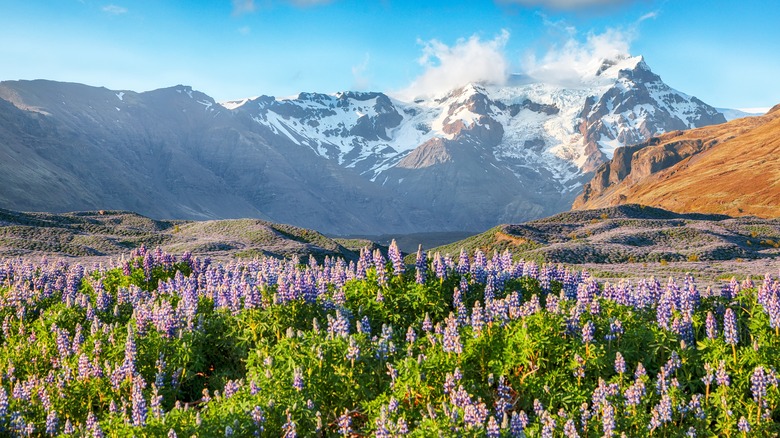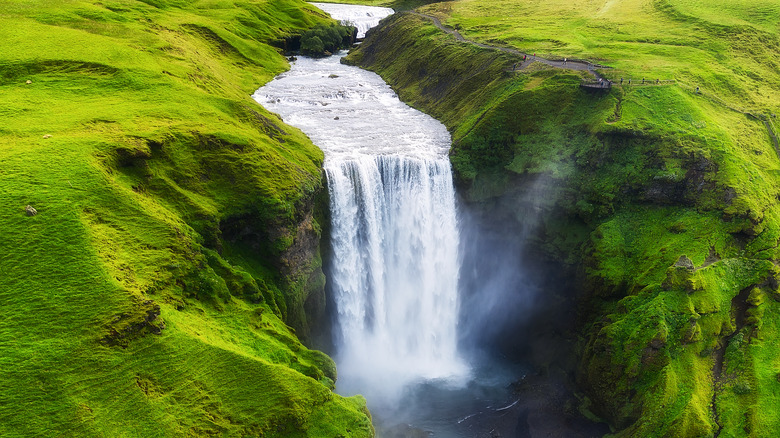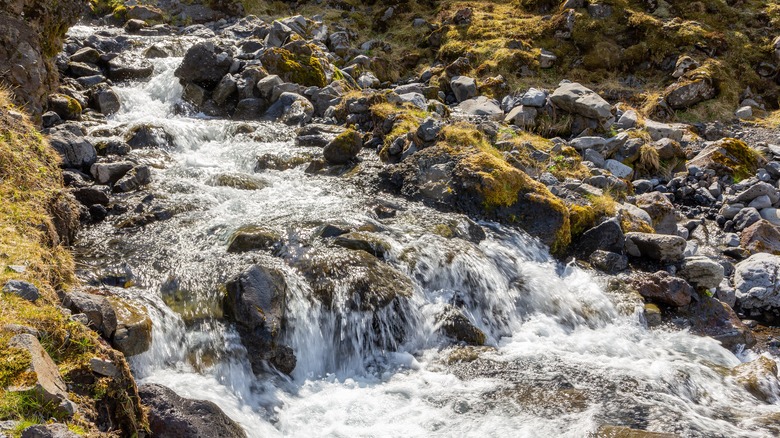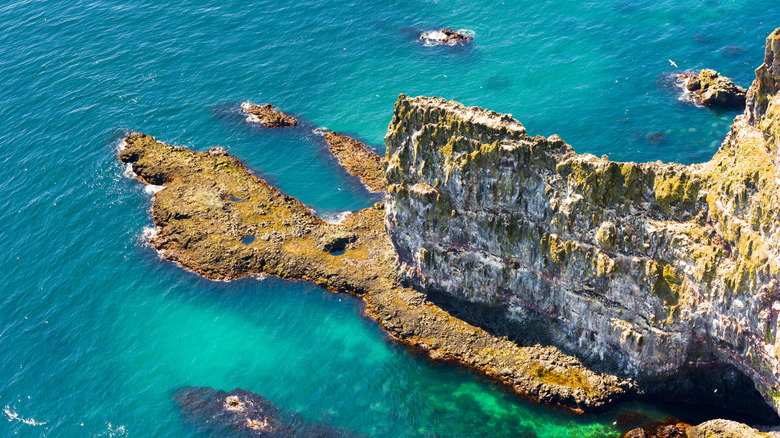Destinations You Shouldn't Miss On Your Vacation To Iceland, According To Travelers
For lovers of the great outdoors, Iceland may seem like a fantasy come to life. This is the realm of fjords, volcanoes, waterfalls, mountains, and glaciers (as the country's name might suggest). Also known as the "land of fire and ice," the nation lets its nature shine. Apart from the capital of Reykjavik, visitors won't find teeming urban areas or masses of people. The landscape has a cinematic quality, so it may be no surprise that it has served as a filming location for movies and TV shows, including "Game of Thrones."
Iceland has a lot to see, and thanks to direct flights from several U.S. cities, it's easy to get there. We've narrowed down the places worth checking out to help you choose where to go on the island. We consulted review sites, travel agent round-ups, travel blogs, and official tourism pages to come up with some prime picks.
Akureyri
Akureyri is a small town on a fjord in the north that serves as a base for whale watching. The creatures have been spotted near the shore, with humpbacks, minke, and bottlenose varieties trawling the water. One of the most notable buildings in the area is the Akureyri Church, which has received an average rating of 4 stars and up on Google and Tripadvisor. The Lutheran place of worship has an exterior with soaring flanks and a stained glass window. Visitors who prefer to stick with outdoor adventures will also find many hiking options. Easy paths around Akureyri, safe for a first solo hike, will bring travelers to many of the town's highlights. Nearby, challenging treks meander up mountains, through canyons, and atop cliffs.
To continue the nature excursion, head to the Akureyri Botanical Garden, which had humble beginnings as a tract of agricultural pasture. In 1910, it was earmarked for use as a garden before opening in 1912. Its location, just south of the Arctic Circle, means it has many hardy plants. Visitors will find several local varieties and more than 6,000 species of flora overall. One commenter on Tripadvisor described their experience at the garden as "an absolute joy wandering around and taking it all in."
Askja
Askja has two lakes: the main Lake Öskjuvatn (sometimes called Lake Askja) and one within the Viti crater. Both are surrounded by mountains and were formed by a volcanic eruption. During the summer months — the best time to visit in terms of weather and access — Viti's water takes on an otherworldly pastel blue hue. While some travelers may feel the scenery is worthy in its own right, more adventurous individuals may set swimming in Viti as their ultimate goal. Its waters hover around the high 70s, making them warm enough for a dip. However, accessing the water comes with potential dangers due to the steepness of the slope.
Lake Askja might look shallow, but its water plunges more than 200 meters (about 650 feet) from the surface, distinguishing it as one of the deepest lakes in the country. One Tripadvisor reviewer described a trip to Askja as feeling "like you are in another world." Note that reaching the site involves long drives over rough roads, making a 4x4 vehicle essential. Basic campsites and cabins allow visitors to stay near the lake, though they have limited capacity.
Blue Lagoon
This bucket-list vacation destination is one of the most famous places in Iceland. You might have seen the Blue Lagoon promoted on a tourism site or a trip offered by a tour operator. One Tripadvisor reviewer described it as "a must do when visiting Iceland." Thermal springs heat the roomy lagoon's Tiffany blue water to 98 to 107 degrees Fahrenheit. The water is rich in minerals, silica, and algae, which the official website claims confers skin benefits. A 2021 study published in Skin Pharmacology and Physiology by scientists in Germany and Iceland supports those claims. The research linked the algae in the Blue Lagoon to the reduction of uneven skin pigmentation and psoriasis improvements. Visitors can also apply silica mud to their faces at the mask bar.
More than just a water park, the Blue Lagoon has two hotels, a spa, and a few places to eat. Visitors can get a day pass that allows access to a steam cave and sauna in addition to the lagoon and mask bar. Other add-ons include a massage treatment in the water or a wider range of treatments at the spa. The lagoon is split into sections, such as a quiet zone, an in-water treatment area, and a waterfall. Can't decide between the classic Blue Lagoon at its newer rival, Sky Lagoon? Take a look at how they compare.
Dettifoss
One of Iceland's thousands of waterfalls, the thundering Dettifoss sits in the country's northern half. While its drop is no match for behemoths like Angel Falls in Venezuela, Dettifoss is broad, with the substantial water power on display fed by a river that originates in the large Vatnajökull glacier. Dettifoss translates to "collapsing waterfall" in English, a name that captures how the raging river drops into a canyon.
Getting to Dettifoss requires more than 6 hours of driving from Reykjavik. Akureyri is much closer, offering a shorter 2-hour journey by vehicle. Though you'll find parking lots near the waterfall, you'll still need to walk a short distance over potentially slippery terrain. Summer is the best time to visit to see the greatest water flow and enjoy more mild air temperatures. There are views from both sides of the falls, but as a commenter on Reddit pointed out, the drive on the "west side is shorter and easier."
Golden Circle
This well-traveled circuit provides visitors with many sights on a tour that covers about 150 miles of roadway to and from Reykjavik. While the Golden Circle can conceivably be done in a day trip, it can easily be extended into a three-day mini vacation. The main components of the excursion are Thingvellir National Park, the Geysir geothermal area, and the Gullfoss waterfall.
Located in Haukadalur, a valley in the south of the country, the geysers include the Great Geysir (the most famous) and another one called Strokkur (geyser derives from the Icelandic "geysir," whose meaning is "to gush"). Visitors will also encounter bubbling mud pools, thermal springs, and areas where steam rises from the ground. Strokkur is the most reliable of the eruptions, firing water 100 feet into the air every 10 minutes.
History and geology intersect at Thingvellir National Park, where people lived as far back as the year 930 AD. The country's political body also held meetings there for centuries, and the park is where Iceland marked its independence from Denmark in 1944. Thingvellir is also a realm of potent tectonic shifts with dramatic scenery. As a Tripadvisor contributor mentioned, in the winter, it's "absolutely beautiful with all the snow." Visitors will see crevasses and canyons, large lakes, and towering waterfalls. Gullfoss, a waterfall that seems to cling to a series of terraces, draws 2,000 tourists each day in the summer.
Grundarfjördur
The small town of Grundarfjördur sits on the Snæfellsness Peninsula, in the west of Iceland. What it lacks in population it more than makes up for in scenery. Less than 1,000 people live in the settlement, with fishing serving as key driver of the economy. According to travel service platform Guide to Iceland, that may slowly change as tourism becomes increasingly popular.
Travelers come to explore the rugged peninsula and the area's principal landmark, Kirkjufell (pictured). Sitting at the edge of town and right by the sea, its name means "Church Mountain." Its unique, conical shape reminded one Tripadvisor commenter of the Matterhorn in the Alps. You'll encounter the Kirkjufellsfoss waterfalls close to the mountain, and some photographers will snap a shot of the cascades and peak together. Within the town, travelers will find places to eat, a gallery that hosts exhibitions, a public library, and hotels. Grundarfjördur also boasts a variety of outdoor activities, from ice climbing to golf.
Jökulsárlón
Seawater that seeps through a channel feeds this vast glacial lake that sits just inland from the coast. Partly fueled by climate change, large chunks of ice detach themselves from the glacier Breioamerkurjökull and gently bob along the Jökulsárlón Glacier Lagoon. The lagoon is not massive (about 7 square miles), but its waters are deep, allowing for huge icebergs to survive and move.
Travelers typically visit Jökulsárlón as part of a tour, taking a boat or kayak around the waters. "This was my favourite place that we visited in Iceland," proclaimed a reviewer on Tripadvisor proclaimed. The icebergs sport vivid colors; some are white, and some appear in the shade Tiffany blue. Visitors will also see icebergs covered in black streaks — ash from old volcanic eruptions on the island. Come in the summer, and you will also spot Arctic terns and skuas, which settle on the lake's edge. Seals live there year-round.
Lake Myvatn
In the north of the country, travelers will find this shallow clear lake. A number of geological features reveal themselves around its shores. These include lava fields, lava towers, mini-craters, and thermal springs. The varied terrain formed about 2,000 years ago when lava flowed into the wetlands. The union of hot and cold generated the unique landscape visible today. A poster on Tripadvisor called it a "lovely lake with gorgeous mountain backdrop."
Myvatn derives from the Icelandic word "myflugnavatan," meaning midge lake. Visitors in the summer will understand the provenance of the name — midge swarms are commonplace at this time. While they irritate humans, midges serve as food to the many ducks that visit. In terms of flora, travelers can look for marimo, an algae that grows into a large, soft ball. Myvatn Nature Baths is a large bathing lagoon with mineral-rich heated water in the area. There is also a Viti crater here (the other one is in Askja), where the water is teal blue.
Landmannalaugar
Driving from Reykjavik to this area of lava fields will take more than three hours, but, like the many reviewers on Tripadvisor who arrived before you, you'll likely feel it merited the trip. Hikers visit to experience the rhyolite mountains in this part of Iceland, with peaks and slopes riddled with color. There are also hot springs for soothing aching limbs (though, according to Epic Iceland, finding a warm spot can prove tricky), and areas for camping. A commenter on Reddit called this destination "nothing short of amazing." As with other remote places in Iceland, getting there requires a 4x4 vehicle, since the access roads are unpaved.
Travelers may choose to unwind in the People's Pool, a thermal spring where the water temperature remains at around 100 degrees Fahrenheit year round. There are also many hiking options, from easy to extreme. One straightforward day hike is the Laugahraun lava field. It's less than 3 miles long and shouldn't take more than a couple of hours. On it, expect to see an array of hues across the landscape, from black to rust to green. More challenging routes include those to the peaks of Mt. Blahnúkúr and Mt. Brennisteinsalda. Julie, one of the experienced travelers behind Earth Trekkers, highlighted the impressive views from both summits.
Reykjavík
The capital and home to much of the country's population, Reykjavik has tons to do and appears on many first-time Iceland trip itineraries. The thoroughfare of Skólavöroustígur is a buzzy shopping haunt where stores and homes mingle with restaurants, cafes, and galleries. Visitors looking for designer duds can drop by Hafnartorg. Museums are also dotted around the city. Perlan Museum, which brings Iceland's outdoors to life, is a highly-rated choice. You can enter an ice cave recreated from mountain ice. There is also a planetarium where images of the Northern Lights bathe the screen. The top-floor observation deck, set around the planetarium dome, offers views of the city that one Tripadvisor commentator described as "amazing."
The soaring Hallgrimskirkja church is another city landmark. Located in the heart of the city, it honors the Icelandic poet Hallgrímur Pétursson and is the biggest church in the country. The tower rises about 230 feet and looks onto mountains and the sea. Hipsters might gravitate toward Laugavegur, a strip of restaurants, shops, and bars that Vogue described as "Iceland's single coolest street." Try to time your trip for late August when the citywide celebration known as Culture Night unfolds across roads, museums, gardens, and squares.
Skaftafell National Park
Back in the Middle Ages, the area where this park sits functioned as a farm estate. It came under the control of the church and later Danish royalty. As the river grew, the land became untenable for agriculture, and farming wound down, gone by the mid-1900s. In 1967, the land was turned into a national park, and now travelers can enjoy its varied topography. Hikes at this park lead to waterfalls, and some even traverse across glaciers, a journey that tour company Arctic Adventures calls "breathtaking." Easy trails include a walk to the Svartifoss waterfall or the Skaftafellsjökull glacier.
More challenging routes wind their way to the peak of Kristínartindar mountain or along Morsárdalur valley. There is even a hike that climbs to the highest peak in Iceland, Hvannadalshnjúkur. Consider starting your trip at the visitor's center, which is staffed by rangers all year and has details on the area, terrain, places to stay, and the hiking routes around the park. In the warmer months, the healthy variety of plant life becomes plain to see. You'll notice birch and rowan trees, bluebells, and yellow saxifrage flowers.
Skógafoss
In the south of the country, not far from the coast, this waterfall is one of the most famous in Iceland. Its convenient location certainly helps with visitor numbers since it sits by the southern part of the Ring Road, the major thoroughfare around Iceland. What also boosts its popularity are the views. Skógafoss is enshrouded by verdant hills in the warmer months and snow-capped glaciers in the distance. The waterfall is 60 meters high (almost 200 feet), with soaring gorge walls hemming in its raging cascade. Visitors can get soaked by the falling spray from the riverside by the bottom of the falls or head to the top of the falls for a different viewpoint. To add to the experience, Visit South Iceland suggests visiting Skógafoss on a sunny day to increase the likelihood of seeing a rainbow (or two) over the water.
Between July and October, fishermen congregate by the waters at the bottom of Skógafoss, hoping to snag some salmon and char. Close to the falls, visitors will come across displays of folk crafts and outdoor dwellings that shadow the country's evolution at Skógar Museum. Other exhibits examine how transport and communication have developed in the past century.
Thórsmörk Nature Reserve
Thórsmörk Nature Reserve offers a number of gorges, waterfalls, and canyons to explore. The reserve, which combines valleys and mountains, sits among many glaciers. One TripAdvisor contributor described the area as "the most beautiful place I visited in Iceland." Another stated that "the views here on a sunny day are second to none." You'll see mountain ridges dusted with snow, sections of black lava rock, and rivers that trace their origins to the glaciers.
The valley is often green, especially in the summer, sitting below the peaks in a misty and humid microclimate. The glaciers shield the valley from the elements, so ferns and moss thrive there. Visitors might spot the Arctic fox while hiking or touring the terrain by horseback. Easy trek options include the Stakkholtsgja waterfall and canyon or the Nauthusagil gorge and waterfall. The reserve is also the start and end of the multi-day Laugavegur hike, suitable only for experienced hikers.
Westfjords
This fjord area in the country's northwest offers 24 hours of light in June. That's good because you'll need the hours to explore Westfjords' gems. Dynjandi, a series of waterfalls, is a mega attraction most famous for the large, broad waterfall that looks like tons of mini cascades corralled together. One Tripadvisor reviewer wrote, "This is a strong contender for our favorite waterfall in all of Iceland, and given the competition that is really saying something."
At Látrabjarg (pictured), you'll find yourself atop cliffs in the country's westernmost portion. They stretch for miles along the coast, rising more than 1,000 feet in the air, and offering distant views. At this altitude, foxes aren't prevalent, which has helped the bird population thrive. Many species, such as puffins, are easy to spot. Next to the cliffs, Breidavik Beach offers golden sand and clear turquoise seas. Elsewhere in Westfjords, Raudasandur's name hints at its appeal — the red color of the sand serves as the beach's main attraction.
Methodology
Iceland has less than 400,000 residents. Most of them live in the capital, Reykjavik, and nearby; much of the rest of the country appears in its natural state. To put together this list, we sought to include some of the most incredible pieces of nature that travelers could see around the island. We also wanted to incorporate places all over Iceland rather than concentrating solely on options close to Reykjavik.
We looked at the review site Tripadvisor and made sure only to feature places that had multiple reviews and got high ratings. We also consulted Reddit for first-hand input from travelers who visited these places and spoke of them in high regard. Other information came from travel blogs, the websites of travel agents and operators like Iceland Travel, and official tourism pages.
To round out the list, we prioritized adding places beyond Iceland's many waterfalls. It was critical to supply a mix of locations, from easily accessible to those that require some effort to reach. That way, at least some choices should appeal to many types of travelers.
